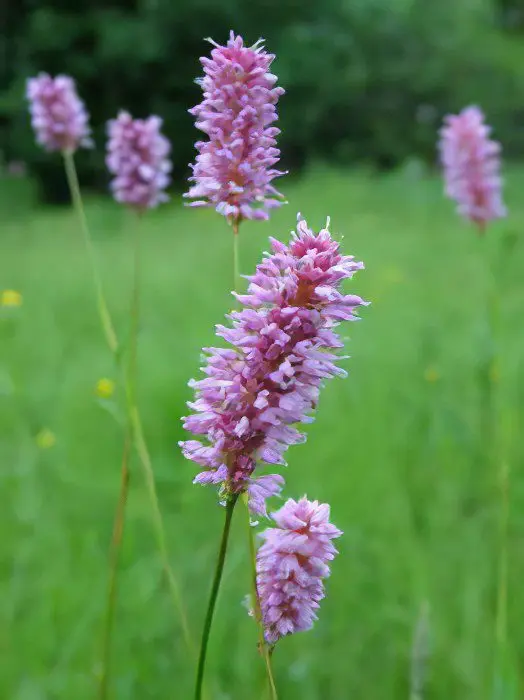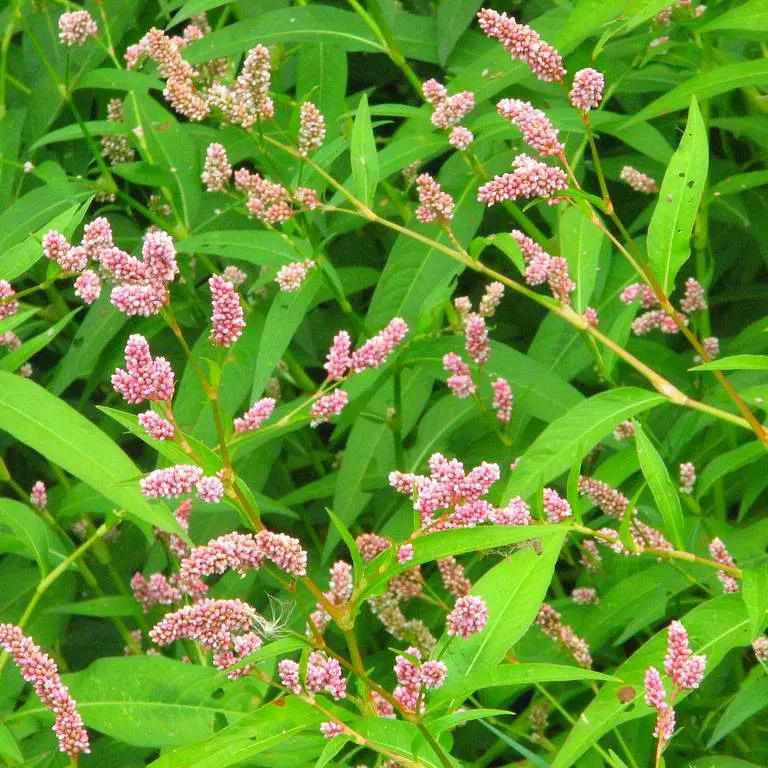Contents
The use of snake mountaineer, kidney mountaineer, bird
Botanical characteristics of the highlander

Highlander – a perennial plant with a height of 30 to 120 cm, characterized by large basal leaves, wavy at the edges, dark green above and bluish below. At the top of the straight stem, small flowers are concentrated, light or dark pink, collected in a spike-shaped inflorescence. The flowering time of the plant is May-July. The rhizome is S-shaped, transversely annular, dotted with numerous roots.
Highlander flooded the European part of the CIS, Buryatia, Krasnoyarsk Territory and most of Siberia. It can be found in meadows with fertile soil, populates the grass of the banks of rivers, the sunny edges of forests. Prefers wet areas of transitional and low-lying swamp margins, river floodplains. The draining of the marshes led to a decrease in the thickets of the snake mountaineer.
Properties of the highlander snake
Medicinal raw materials are harvested in May. During this period, the rhizomes contain a large amount of tannins. The washed roots are dried in the open air, sheltering from direct sunlight. Outside, dark brown, inside pinkish with a brown tint, the roots have an astringent, bitter taste. The roots contain gallic acid, catechin, hydroxymethylanthraquinones, a large amount of starch, calcium oxalate. Also, the rhizome is rich in ash, macronutrients, starch and protein. Means based on mountaineer snake have astringent, anti-inflammatory and hemostatic properties, have a resorptive (after absorption into the blood) calming effect. Flowers contain ascorbic acid and flavonoids.
The use of highlander snake
At the beginning of the use of the mountaineer snake inside, it is not always possible to achieve a quick positive effect on improving the condition, since the astringent properties appear slowly, the splitting of the active substances under the influence of digestive juices must occur. Over time, the intake of medicinal herbs leads to a good, stable therapeutic result. External use for wounds and various rashes has an astringent, anti-inflammatory and hemostatic effect. Highlander snake – a source of tannins, useful for diarrhea and as a means for rinsing the mouth and throat with inflammation.
In folk medicine, the mountaineer rhizome is effective in diseases of the gastrointestinal tract, gallstone and urolithiasis, internal bleeding. With it, relieve inflammation in cholecystitis, cystitis. The rhizome is used as an ideal remedy for douching in gynecological diseases. In China, the rhizomes are used to treat various tumours. Tincture of the rhizomes of the mountaineer snake is suitable for the treatment of stomach ulcers and duodenal ulcers, relieves dysentery, female diseases, and soothes nervous disorders. Externally, the plant is used as a lotion for bleeding wounds and ulcers. The root of the mountaineer, crushed into powder, dissolves abscesses. 0,5-1 gram of powder taken three times a day is enough to get rid of dysentery and indigestion.
Infusion of mountaineer snake: 2 teaspoons of the root must be poured into a thermos with 1 glass of boiling water, insist and drink the entire tincture during the day, dividing the volume into four parts. It is not recommended to consume spicy and protein foods during treatment.
Decoction of the highlander snake
Recipe №1. 2-3 teaspoons of the root should be poured with 1 glass of water, boiled for 10-15 minutes. It is recommended to take the remedy 1-2 tablespoons 3-4 times a day.
Recipe №2. A liquid decoction of a snake mountaineer is prepared at the rate of 10 g of raw materials per 200 ml of water. The rhizome is crushed into pieces no larger than 3 mm, fruits and seeds – no more than 5 mm, poured with water at room temperature, closed and heated in a boiling water bath with frequent stirring for 30 minutes, filtered immediately after removal from the water bath. Take a decoction of 1 tablespoon 3-4 times a day before meals.
Persicaria maculosa

Knotweed is an annual grass reaching 1 m in height. The plant has a taproot, weakly branched root. The stem of this species of highlander is erect, with branches, knotty. The leaves are alternate, lanceolate, with a reddish spot on the surface.
The highlander blooms in June-August with small flowers of a pink hue, which form a spike-shaped inflorescence. The black, shiny fruit is egg-shaped. This species grows in Europe and Asia, Russia, it is adapted to the climatic conditions of North America. It can be found along roads, rivers, near irrigation canals, in fields, orchards and orchards.
Knotweed herb contains tannin, gallic acid, flobafens, essential oil, flavone derivatives, hyperoside, avicularin, quercitrin, rutin. It also revealed the presence of acetic, ascorbic and butyric acids, a lot of vitamin K, mucus, pectin, calcium oxalate, sugar.
The infusion and liquid extract of the kidney mountaineer affect vasoconstriction, increase blood clotting and viscosity, increase uterine contractions, increase tone and increase intestinal motility, and improve heart function.
The extract exhibits diuretic properties, has a laxative effect in chronic, atonic and spastic constipation. Patients suffering from constipation of a proctogenic nature are prescribed an infusion of the herb of the highlander of the kidney.
Infusion of mountaineer kidney: 10 g of dry grass is poured into a glass of hot boiled water, brewed for 30 minutes. in a water bath. It is recommended to take the remedy from 1 tablespoon to 100 ml 3 times a day before meals for 7-21 days. The dose can be selected individually. Also, this infusion is suitable for the treatment of hemorrhoids, rectal fissures with frequent bleeding and for douching with colpitis.
Often cystitis is accompanied by bloody secretions, in this case, the knotweed acts as a hemostatic, anti-inflammatory and analgesic. taking the herb improves well-being in bladder cancer.
knot-grass
Highlander bird – a plant with an erect stem up to 60 cm long, has many branches, the base can lie on the ground or rise up, has a large number of nodes. The tap root of the plant is thick, slightly branched.
Leaflets are alternate, elliptical or linear-lanceolate, small, grayish-green. The flowers are also small, light green, with pink or white lobes along the edges. They are located in bunches in the axils of the leaves. The flowering of the plant begins in April and continues until the last month of autumn. The ripening of the fruit, similar to a nut, occurs from July to September.
This species grows in empty fields, wastelands, inhabits the banks of rivers, yards, paths, etc. It is not found only in the Arctic and Antarctica.
Highlander bird is used as decoctions, infusions for intestinal disorders, dysentery, cholecystitis. In the form of lotions and powders, it is used for inflammatory skin diseases. Means prepared on the basis of highlander bird, make rinsing of the mucous membranes of the mouth with scurvy, stomatitis.
Douching is effective for cystitis, colpitis, vaginitis. Useful active substances are found in the herb. The roots contain a large amount of ascorbic acid, anthraquinones, vitamins E, K and provitamin A, avicularin, hyperin, isorhamnetin, myricetin, quercetin and kaempferol, tannins, essential oil, coumarins. Scopoletin and umbelliferon, gallic, coffee, coumaric, chlorogenic acids, resins, mucus and silicic acid compounds have also been identified.
The flowers of the plant are rich in flavonoids. The entire above-ground part is endowed with ash, macro- and microelements. Active substances in various diseases are silicic acid, mucus, tannins, flavonoids and saponin. Knotweed is a component of teas used for coughs and lung diseases. When regulating metabolism, the use of teas with highlander helps to purify the blood.
Infusion of herb mountaineer bird: 3 tablespoons of raw materials are placed in an enamel bowl, pour 200 ml of hot boiled water, close the lid and heat in a water bath for 15 minutes, cool at room temperature for 45 minutes, filter, squeeze the remaining raw materials. The volume of the resulting infusion is adjusted with boiled water to 200 ml. Take the remedy for 1/3-1/2 cup 2-3 times a day before meals.
A decoction of the herb mountaineer bird: The decoction is prepared in the ratio of raw materials to water 1:10. The crushed grass is poured with water at room temperature, put in a water bath for 30 minutes, cooled for 15 minutes, then filtered. It is recommended to take the remedy 1 tablespoon 3 times a day.
Highlander bird’s juice: juice is squeezed from adult plants collected during the flowering period. Take 1/2-1 cup, adding a spoonful of honey, 2-3 times a day for 30 minutes. before meals.
Flavonoids, silicon compounds and tannins contained in the knotweed prevent the formation of urinary stones and have a hypotensive effect.
Serpentine mountaineer root
The root of the knotweed snake is an ideal raw material for the preparation of medicinal products. It is harvested in August-October, dried in the open air, covering from rain and sunlight. Dried roots are odorless, have a brownish-pink color when broken, and can be stored for two years.
Contraindications to the use of snake mountaineer
Contraindications for the use of snake mountaineer are acute inflammation of the kidneys and bladder. Due to the fact that the plant is characterized by a blood-clotting effect, it should not be taken by people suffering from thrombophlebitis and pregnant women.










